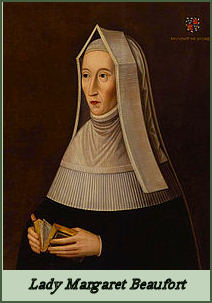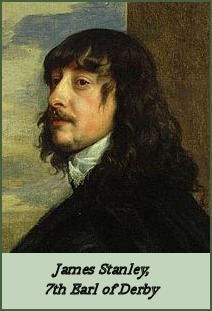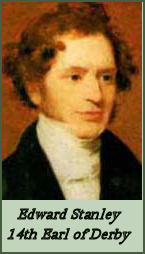The Stanley Earls of Derby
 The first recorded ancestor of the Stanley family was the Norman Adam de Audithlegh, who fought at the Battle of Hastings with William the Conqueror, for which he was rewarded with large estates. The surname derived from his family's estates at Audithlegh in Normandy.
The first recorded ancestor of the Stanley family was the Norman Adam de Audithlegh, who fought at the Battle of Hastings with William the Conqueror, for which he was rewarded with large estates. The surname derived from his family's estates at Audithlegh in Normandy.
Adam had 2 sons, Lyulph and Adam de Audithlegh, Adam, the younger son, married an Anglo-Saxon heiress whose lands included Stoneley, near Leek in Staffordshire, from which the name Stanley derived. His 3 greats-grandson, Sir William de Stanley further increased the family's fortunes by marrying Joan, the daughter and heiress of Sir Philip Bamville, Master Forester of the Wirral, and lord of Storeton near Birkenhead, at Astbury Church in 1282. Through the marriage the Stanley family acquired one-third of the manor of Storeton, he later gained the remaining two-thirds and the hereditary chief rangership of the Forest of Wirral, which then extended over the entire peninsula.
Sir William Stanley, great grandson of the former William, married Alice, daughter of Sir Hamo de Massey of Timperley. Their son, Sir John de Stanley, was appointed as deputy to Robert de Vere, Duke of Ireland in 1386. Stanley led an expedituion to Ireland on behalf of de Vere and King Richard II to quell an insurection. Due to the success of the expedition, Stanley was appointed to the position of Lieutenant of Ireland. In 1389, Richard II appointed him justiciar of Ireland, a post he held until 1391. He was heavily involved in Richard's first expedition to Ireland in 1394–1395. Sir John married Isabel, daughter and heiress of Sir Thomas de Lathom, lord of Lathom and Knowsley in Lancashire. In 1405 he was granted the tenure of the Isle of Man by King Henry IV which had been confiscated from the rebellious Henry Percy, 1st Earl of Northumberland. He and his descendants ruled as Kings of Man until 1736.
 His son Sir John Stanley, twice visited the Isle of Mann to put down rebellions (1417 and 1422) and was also responsible for putting the laws of the Island into writing. He purchased the Advowson of Rectory of Winwick, Cheshire from the Nostell Priory, Wakefield in 1433 and from this time onwards, this church, adjacent to his property, was to have close links with the Stanley family. Thomas Stanley, 1st Baron Stanley, the son of Sir John Stanley and Elizabeth Harrington, served as Lord Lieutenant of Ireland from 1431 to 1436 and was appointed comptroller of the royal household by Henry VI in 1432. He married Joan Goushill, the daughter and coheiress of Sir Robert Goushill and Elizabeth FitzAlan, daughter of Richard Fitzalan, 11th Earl of Arundel.
His son Sir John Stanley, twice visited the Isle of Mann to put down rebellions (1417 and 1422) and was also responsible for putting the laws of the Island into writing. He purchased the Advowson of Rectory of Winwick, Cheshire from the Nostell Priory, Wakefield in 1433 and from this time onwards, this church, adjacent to his property, was to have close links with the Stanley family. Thomas Stanley, 1st Baron Stanley, the son of Sir John Stanley and Elizabeth Harrington, served as Lord Lieutenant of Ireland from 1431 to 1436 and was appointed comptroller of the royal household by Henry VI in 1432. He married Joan Goushill, the daughter and coheiress of Sir Robert Goushill and Elizabeth FitzAlan, daughter of Richard Fitzalan, 11th Earl of Arundel.
Thomas Stanley, son of Sir John and Joan, born circa 1435, inherited his father's titles, including that of King of Mann and Baron Stanley. Stanley owned what is now Tatton Park in Cheshire. During the brief reign of Edward V Lord Stanley was one of the nobles arrested at the council board in Richard of Gloucester's (later Richard III) coup d'état of the 13th June, 1483. He married, firstly Eleanor, sister of Richard Neville, Earl of Warwick and secondly to Lady Margaret Beaufort, the mother of Henry VII, as his second wife. On the landing of the future Henry VII at Milford Haven, Lord Stanley, on a plea of illness, refused a request to join Richard III but was kept from openly joining Henry, by the fact that his son, Lord Strange, was detained as a hostage in Richard's power as a security for his father's good faith. He was created Earl of Derby after playing a decisive part in the Battle of Bosworth field, which placed his step-son and the Tudor dynasty on the throne of England and is reputed to have retrieved the crown of England from the battlefield and placed it on the head of his own stepson. The title derives from the area in South Lancashire known as West Derby and not from the city of Derby. His brother William Stanley was later convicted of treason and executed by Henry VII for his support of the pretender Perkin Warbeck.
Thomas Stanley was succeeded as Earl of Derby by his grandson Thomas Stanley, having been predeceased by his eldest son by a matter of months. Thomas, the eldest son of George Stanley and Joan Strange, 9th Baroness Strange and 5th Baroness Mohun, fought with King Henry VIII at the Battle of the Spurs in France in 1513. Both he and his wife, Anne Hastings, were in attendance at the Field of the Cloth of Gold in June 1520, and Derby attended the King at his meeting with the Emperor Charles V at Dover later that year. He was succeeded as Earl of Derby by his son Edward Stanley, who inherited the title at the young age of thirteen. King Henry VIII assumed responsibility for his upbringing. His commissioners, including Cardinal Thomas Wolsey, were responsible for most of his affairs. In 1528, he accompanied Cardinal Wolsey on a mission to France, and in 1530, he was one of the peers who gave Pope Clement VII the declaration regarding Henry's divorce from Catherine of Aragon. In 1532, he accompanied the king to Boulogne, where they met with King Francis I of France. A few years later, Edward took a major role in quelling the Pilgrimage of Grace, a rebellion started in Lincolnshire and spread into North England. Edward later served as Lord High Steward at the coronation of Queen Mary in 1553 and was a commissioner st the trial of Lady Jane Grey.
Henry, 4th Earl of Derby was the son of the 3rd Earl and Dorothy Howard, daughter of Thomas Howard, 2nd Duke of Norfolk He served as Ambassador to France and as a judge at the infamous trial of Mary, Queen of Scots, in 1586. He was married to Margaret Clifford, daughter of Henry Clifford, 2nd Earl of Cumberland, and his wife Eleanor Brandon and grandaughter of King Henry VII and Elizabeth of York. Eleanor was the younger daughter of Charles Brandon, 1st Duke of Suffolk, and his wife Mary Tudor, the sister of King Henry VIII.
His eldest son Ferdinando Stanley, the fifth Earl, built Leasowe Castle, most likely as an observation platform for watching horse races on the nearby sands. He married Alice Spencer, daughter of John Spencer of Althorpe, but the marriage did not produce a son. A supporter of the arts, he enjoyed music, dance, poetry, and singing, and especially the theatre. He was the patron of many writers including Robert Greene, Christopher Marlowe, Edmund Spenser and William Shakespeare. Ferdinando died in mysterious circumstances and claims were made that he had been poisoned to prevent him from staking a claim to the throne of England through his maternal grandmother, Mary Tudor. He was taken ill suddenly with severe and violent sickness and rumour stated he had been poisoned by the Jesuits, his gentleman of horse being suspected of administering the poison. The baronies of Stanley, Strange and Mohun fell into abeyance between his three daughters.
 He was succeeded by his younger brother William, sixth Earl of Derby who was Lord Lieutenant of Lancashire and Cheshire and purchased the family claims on the Isle of Man from his nieces. William married Elizabeth de Vere daughter of Edward de Vere, 17th Earl of Oxford. His son James Stanley supported the Royalist cause during the Civil War, He raised troops in Lancashire to fight in the Bishops' Wars (1639-40) and became involved in some of the earliest fighting of the English Civil War. James Stanley succeeded to the earldom of Derby on his father's death in September 1642, while he was engaged in an attempt to besiege Manchester, which was abandoned early in October. He concentrated Royalist forces around Preston, Wigan and at his headquarters in Warrington. During the spring of 1643, with many of his best troops transferred to the Oxford army, he was gradually hemmed in around Warrington by Parliamentary forces. On 20th April, he suffered defeated at Whalley Abbey at the hands of Colonel Ashton and in June 1643 moved to the Isle of Man establishing it as a Royalist stronghold, he rejected an order to surrender the island after the declaration of the Commonwealth in 1649.
He was succeeded by his younger brother William, sixth Earl of Derby who was Lord Lieutenant of Lancashire and Cheshire and purchased the family claims on the Isle of Man from his nieces. William married Elizabeth de Vere daughter of Edward de Vere, 17th Earl of Oxford. His son James Stanley supported the Royalist cause during the Civil War, He raised troops in Lancashire to fight in the Bishops' Wars (1639-40) and became involved in some of the earliest fighting of the English Civil War. James Stanley succeeded to the earldom of Derby on his father's death in September 1642, while he was engaged in an attempt to besiege Manchester, which was abandoned early in October. He concentrated Royalist forces around Preston, Wigan and at his headquarters in Warrington. During the spring of 1643, with many of his best troops transferred to the Oxford army, he was gradually hemmed in around Warrington by Parliamentary forces. On 20th April, he suffered defeated at Whalley Abbey at the hands of Colonel Ashton and in June 1643 moved to the Isle of Man establishing it as a Royalist stronghold, he rejected an order to surrender the island after the declaration of the Commonwealth in 1649.
James fought with the future Charles II at the Battle of Worcester in 1651 and helped Charles to escape after the battle, guiding him to the Penderells at Boscobel House, then made his way northwards with other fugitives. He was placed under arrest at Stanley Palace in Chester, and later transported to Bolton where he was beheaded. His wife was Charlotte de la Trémouille, daughter of Claude de la Trémoille, Duc de Thouars, and grand-daughter of William the Silent, Prince of Orange, she defended Lathom House in 1644 and the Isle of Man in 1651.
Their son Charles Stanley succeed to the title as the 8th Earl of Derby. He was appointed Lord Lieutenant of both Cheshire and Lancashire. Charles married Dorothea Helena Kirkhoven, daughter of Baron Rupa of the Netherlands. The 8th Earl's eldest son William Richard George Stanley became the 9th Earl. He married Elizabeth Butler, daughter of Thomas Butler, Earl of Ossory, the marriage two daughters and one son.
 The 9th Earl's son predeceased him and he was succeeded as Earl of Derby by his younger brother, James Stanley, the tenth Earl, who served as Chancellor of the Duchy of Lancaster and as Captain of the Yeomen of the Guard. He developed Knowsley Hall (pictured right) from a building that was originally a medieval hunting lodge in the estate of Lathom House and built up an important collection of Old Master paintings. In 1732 he succeeded his great-niece as 6th Baron Strange. He had no issue and on his death in 1736 the male line of the second Earl became extinct. He was succeeded in the barony of Strange, by his first cousin once removed, James Murray, 2nd Duke of Atholl. The earldom was inherited by his distant cousin,
The 9th Earl's son predeceased him and he was succeeded as Earl of Derby by his younger brother, James Stanley, the tenth Earl, who served as Chancellor of the Duchy of Lancaster and as Captain of the Yeomen of the Guard. He developed Knowsley Hall (pictured right) from a building that was originally a medieval hunting lodge in the estate of Lathom House and built up an important collection of Old Master paintings. In 1732 he succeeded his great-niece as 6th Baron Strange. He had no issue and on his death in 1736 the male line of the second Earl became extinct. He was succeeded in the barony of Strange, by his first cousin once removed, James Murray, 2nd Duke of Atholl. The earldom was inherited by his distant cousin,
Sir Edward Stanley, 5th Baronet, of Bickerstaffe Hall near Ormskirk, a distant cousin of the 10th Earl and descendant of a younger brother of the second Earl, who became the 11th Earl of Derby. The Baronetcy of Bickerstaffe had been created in 1627 for Edward Stanley, the great-grandson of Sir James Stanley, of Cross Hall, younger brother of the second Earl of Derby.
The 11th Earl was succeeded by his grandson Edward Smith-Stanley, the 12th Earl, the son of James Smith-Stanley, the 12th Earl was a passionate sportsman and founded the two classic horse races - The Derby and The Oaks. He married Lady Elizabeth Hamilton, daughter of James, 6th Duke of Hamilton. He was married for a second time to a Drury Lane actress, Elizabeth Farren. He was suceeded by Edward Smith-Stanley, 13th Earl of Derby, his son by his first marriage. He was an eminent natural historian and his zoological collections founded Liverpool Museum, he established an aviary and menagerie in Knowsley Park. He was also a patron of the arts and of the poet and watercolourist, Edward Lear who wrote The Owl and the Pussycat for the Earl's children.
 His son, Edward George Geoffrey Smith-Stanley, 14th Earl of Derby became a great parliamentary orator, he sat as Member of Parliament for Stockbridge, Windsor and Lancashire North. Although formerly a Whig politician, he later switched to the Tory party and was appointed Prime Minister three times. He was responsible for steering the Slavery Abolition Act through Parliament and in his third administration the Second Reform Bill was passed. His eldest son Edward Henry Stanley, the 15th Earl, was a prominent politician and served under his father as Parliamentary Under-Secretary of State for Foreign Affairs and Foreign Secretary. He became Foreign Secretary again under the great victorian Prime Minister, Benjamin Disraeli. In 1880 he joined the Liberal Party and was Colonial Secretary under William Gladstone between 1882 and 1885.
His son, Edward George Geoffrey Smith-Stanley, 14th Earl of Derby became a great parliamentary orator, he sat as Member of Parliament for Stockbridge, Windsor and Lancashire North. Although formerly a Whig politician, he later switched to the Tory party and was appointed Prime Minister three times. He was responsible for steering the Slavery Abolition Act through Parliament and in his third administration the Second Reform Bill was passed. His eldest son Edward Henry Stanley, the 15th Earl, was a prominent politician and served under his father as Parliamentary Under-Secretary of State for Foreign Affairs and Foreign Secretary. He became Foreign Secretary again under the great victorian Prime Minister, Benjamin Disraeli. In 1880 he joined the Liberal Party and was Colonial Secretary under William Gladstone between 1882 and 1885.
His younger brother, Frederick Arthur Stanley, 16th Earl of Derby, was a Conservative politician and held office as Secretary of State for War and as Colonial Secretary He was also Governor-General of Canada between 1888 and 1893. In 1892, the 16th Earl purchased and donated the Stanley Cup, to be awarded to the "championship hockey club of the Dominion of Canada" each year.
Edward George Villiers Stanley, the 17th Earl was the son of the 16th Earl and Lady Constance Villiers, daughter of George William Villiers, 4th Earl of Clarendon. He served as Secretary of State for War and Ambassador to France, involved in negotiating the Treaty of Versailles. He followed his father's lead by donating the Lord Derby Cup, given each year to the winners of the French rugby league knockout competition.
He outlived his eldest son to be succeeded by his grandson Edward John Stanley, the eldest son of Edward Montagu Cavendish Stanley, Lord Stanley. He was Lord Lieutenant of Lancashire and established Knowsley Safari Park in 1971. He was succeeded by his nephew Edward Richard William Stanley, 19th Earl of Derby, the son of Hugh Henry Montagu Stanley and the present holder of the title. He is married to Caroline Emma Neville, his heir is Edward John Robin Stanley, Lord Bickerstaffe
Back to Cheshire and Derbyshire history menu
